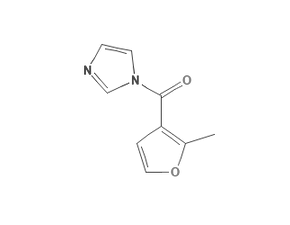
5S rRNA modificator
CAS No. 1415238-77-5
5S rRNA modificator ( 5S rRNA modificator )
Catalog No. M17282 CAS No. 1415238-77-5
5S rRNA modificator, used in 5S rRNA RNA modification, is a suitable electrophile for 2’-hydroxyl acylation on structured RNA molecules.
Purity : 98%
 COA
COA
 Datasheet
Datasheet
 HNMR
HNMR
 HPLC
HPLC
 MSDS
MSDS
 Handing Instructions
Handing Instructions
| Size | Price / USD | Stock | Quantity |
| 2MG | 51 | In Stock |


|
| 5MG | 80 | In Stock |


|
| 10MG | 147 | In Stock |


|
| 25MG | 311 | In Stock |


|
| 50MG | 483 | In Stock |


|
| 100MG | 698 | In Stock |


|
| 500MG | 1431 | In Stock |


|
| 1G | Get Quote | In Stock |


|
Biological Information
-
Product Name5S rRNA modificator
-
NoteResearch use only, not for human use.
-
Brief Description5S rRNA modificator, used in 5S rRNA RNA modification, is a suitable electrophile for 2’-hydroxyl acylation on structured RNA molecules.
-
Description5S rRNA modificator is a rRNA modification agent. 5S rRNA modificator worked as an electrophile for 2’-hydroxyl acylation on structured RNA molecules, yielding accurate structural information comparable to that obtained with existing probes; 5S rRNA RNA modification.
-
Synonyms5S rRNA modificator
-
PathwayPI3K/Akt/mTOR signaling
-
TargetPI3K
-
RecptorOthers
-
Research AreaOthers-Field
-
Indication——
Chemical Information
-
CAS Number1415238-77-5
-
Formula Weight176.17
-
Molecular FormulaC9H8N2O2
-
Purity98%
-
Solubility——
-
SMILESCc1c(cco1)C(=O)n1ccnc1
-
Chemical NameImidazol-1-yl-(2-methylfuran-3-yl)methanone
Shipping & Storage Information
-
Storage(-20℃)
-
ShippingWith Ice Pack
-
Stability≥ 2 years
Reference
1. Spitale RC, et al. RNA SHAPE analysis in living cells. Nat Chem Biol. 2013 Jan;9(1):18-20.
molnova catalog


related products
-
PI3Kα-IN-5
PI3Kα-IN-5 is a potent, selective PI3Kα inhibitor with enzyme IC50 and cell IC50 of 6 nM and 87 nM respectively.
-
GDC-0941 dimethanesu...
A potent, selective, orally bioavailable inhibitor of class I PI3Ks with IC50 of 3/33/3/75 nM for p110α/β/γ/δ, respectively.
-
MOMIPP
MOMIPP is a PIKfyve inhibitor and a macropinocytosis inducer. MOMIPP readily penetrates the blood-brain barrier and is moderately effective in suppressing progression of intracerebral glioblastoma xenografts.



 Cart
Cart
 sales@molnova.com
sales@molnova.com


